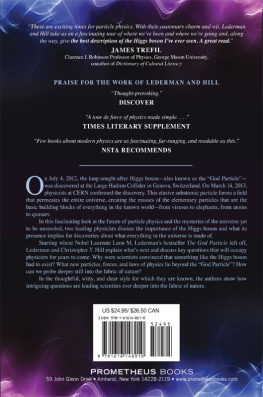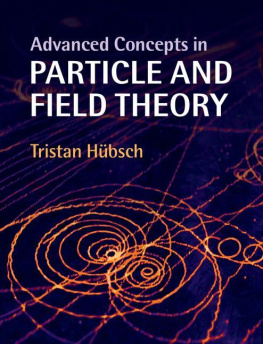PARTICLE
PHYSICS
LICENSE, DISCLAIMER OF LIABILITY, AND LIMITED WARRANTY
By purchasing or using this book (the Work), you agree that this license grants permission to use the contents contained herein, but does not give you the right of ownership to any of the textual content in the book or ownership to any of the information or products contained in it. This license does not permit uploading of the Work onto the Internet or on a network (of any kind) without the written consent of the Publisher. Duplication or dissemination of any text, code, simulations, images, etc. contained herein is limited to and subject to licensing terms for the respective products, and permission must be obtained from the Publisher or the owner of the content, etc., in order to reproduce or network any portion of the textual material (in any media) that is contained in the Work.
MERCURY LEARNING AND INFORMATION (MLI or the Publisher) and anyone involved in the creation, writing, or production of the companion disc, accompanying algorithms, code, or computer programs (the software), and any accompanying Web site or software of the Work, cannot and do not warrant the performance or results that might be obtained by using the contents of the Work. The author, developers, and the Publisher have used their best efforts to insure the accuracy and functionality of the textual material and/or programs contained in this package; we, however, make no warranty of any kind, express or implied, regarding the performance of these contents or programs. The Work is sold as is without warranty (except for defective materials used in manufacturing the book or due to faulty workmanship).
The author, developers, and the publisher of any accompanying content, and anyone involved in the composition, production, and manufacturing of this work will not be liable for damages of any kind arising out of the use of (or the inability to use) the algorithms, source code, computer programs, or textual material contained in this publication. This includes, but is not limited to, loss of revenue or profit, or other incidental, physical, or consequential damages arising out of the use of this Work.
The sole remedy in the event of a claim of any kind is expressly limited to replacement of the book, and only at the discretion of the Publisher. The use of implied warranty and certain exclusions vary from state to state, and might not apply to the purchaser of this product.
PARTICLE
PHYSICS
An Introduction
ROBERT PURDY, PHD

Copyright 2018 by MERCURY LEARNING AND INFORMATION LLC. All rights reserved.
Original title and copyright: The Fundamentals of Particle Physics by Robert Purdy. Copyright 2017 Pantaneto Press. All rights reserved.
This publication, portions of it, or any accompanying software may not be reproduced in any way, stored in a retrieval system of any type, or transmitted by any means, media, electronic display or mechanical display, including, but not limited to, photocopy, recording, Internet postings, or scanning, without prior permission in writing from the publisher.
Publisher: David Pallai
MERCURY LEARNING AND INFORMATION
22841 Quicksilver Drive
Dulles, VA 20166
www.merclearning.com
1-800-232-0223
This book is printed on acid-free paper.
R. Purdy. Particle Physics: An Introduction.
ISBN: 978-1-683921-42-4
The publisher recognizes and respects all marks used by companies, manufacturers, and developers as a means to distinguish their products. All brand names and product names mentioned in this book are trademarks or service marks of their respective companies. Any omission or misuse (of any kind) of service marks or trademarks, etc. is not an attempt to infringe on the property of others.
Library of Congress Control Number: 2017960711
171819321 Printed in the United States of America
Our titles are available for adoption, license, or bulk purchase by institutions, corporations, etc. For additional information, please contact the Customer Service Dept. at 1-(800)-232-0223.
The sole obligation of MERCURY LEARNING AND INFORMATION to the purchaser is to replace the book, based on defective materials or faulty workmanship, but not based on the operation or functionality of the product.
To my parents, who have always listened to my ramblings
CONTENTS
INTRODUCTION
WHY STUDY PARTICLE PHYSICS?
Particle physics remains one of the most popular aspects of the study of modern physics. Not only is the subject popular among physics students, it also captures the imagination of the general public. Admittedly, a part of the reason for this may be that the machines constructed for the fields continued development are easily some of the most awe-inspiring engineering feats in human history. However, I do not think that this is the full story. Rather, I believe that the appeal of particle physics is that it addresses some of the key questions that lead people to an interest in physics in the first place. First, particle physics, arguably more than any other discipline, aims to answer the question of what the universe is ultimately made of. In my opinion, the only other discipline to address such weighty problems is cosmology, and the two could not be more different in their approach. While cosmology studies the overall structure and history of the universe on the grandest scaleswhat we might call the holistic approachparticle physics is concerned with building a universe from its simplest constituents. We can think of this as a constructionist or bottom up approach to understanding the world. This said, the aim of the two disciplines is ultimately the same, and so despite the many orders of magnitude between the scales of their realms of study, there is a surprising amount of overlap between the two. This is a point that we will explore a little in the final chapter of this book.
The second reason I believe particle physics appeals to many is that it is built upon a few guiding principles. Chief among these is the role that symmetry plays in our universe. As we will see throughout this text, symmetry and its implications play a pivotal role in the field of particle physics. As such, there is an elegance and beauty underlying much of modern particle physics. Indeed, it is the desire to produce a more symmetrical theory that has led to many of the developments in the history of particle physics, including as-yet purely hypothetical developments such as supersymmetry and grand unification. The drive to develop theories of the world that are elegant, simple, and symmetrical is not unique to particle physics of course: it is a principle adhered to by all areas of physics, dating back at least as far as William of Ockham and his famous razor in the fourteenth century. However, since particle physics develops this idea to its full potential, this is just another reason that students of physics are commonly drawn to this field.
THE AIM OF THIS BOOK
This book has three main aims. First, I wish to introduce the reader to the concepts of particle physics. As a theorist, my approach to this is mainly to come at things from a theoretical point of view. As such, the emphasis is on developing the ideas of particle physics that are mathematically consistent and then showing that they apply to the real world. This is as opposed to the (arguably more historically accurate) approach of finding and refining theories that fit the experimental observations. In this way, the reader will hopefully develop an appreciation for the elegance of the subject and its reliance on symmetry and simplicity as guiding principles. This said, even as a theorist, I must acknowledge that occasionally it is necessary to observe the real world to ensure that our theories are on the right track. As such, an introduction is given in to some aspects of experimental physics and of how we may compare theory with experiment.












